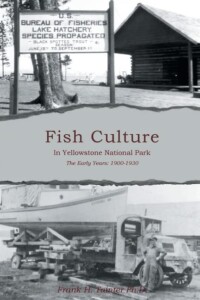Title: Fish Culture in Yellowstone National Park: The Early Years: 1901-1930
Author: Frank H. Tainter, Ph.D.
Publisher: Bookside Press
ISBN: 1998784762
Pages: 198
Genre: Historical Non-Fiction
Reviewed by: David Allen
Pacific Book Review
Fish Culture in Yellowstone National Park by Dr. Frank H. Tainter is a lot more than a fish tale. Those whose lives are immediately touched by historical curiosity, a love of nature, or geographic propinquity to Yellowstone will find a treasure trove of information, history and curiosity here. It also has a great deal to recommend it to general readers.
Let’s put this remarkable book in context. Dr. Tainter’s book, although not a follow up to Richard Brautigan’s fictional Trout Fishing in America, actually follows robustly in that same tradition: Fish Culture is a hale and hearty smorgasbord of what’s good and true in America. The book depicts real human beings at work, wresting prize trout by the truckload from hatcheries and spawning grounds, the hand of man supplanting and maybe even improving upon what Nature first provided.
Documentary and journalism about where real people work and how they perform their work has always been popular – especially when it is as sincere, heartfelt, and detailed – as much a labor of love – as the present volume is. Tainter’s world, and the book he wrote, say a lot about our efforts to modulate, tame, and otherwise control the environment. The book comes at a time when ecological events are front page news.
Frank H. Tainter’s father, uncles, and grandfather all worked on fish culture for the (former) U.S. Bureau of Fisheries at Yellowstone during the nineteen-teens and nineteen-twenties. Through copious illustrations, including maps, wonderful photographs of the work crews and foremen, and reproductions of work manifests with crew members’ names and job descriptions, we come to know, live and breathe the lives of these fishermen and women. The men and women on these teams operated from one of three stations in the region, including Spearfish and Bozeman.
For a particularly poignant window on that time and sensibility, check out the chapter ‘Living Conditions at the Lake Hatchery in 1925.’ Also check out the thrilling details of Herbert Hoover’s and Calvin Coolidge’s visits to Yellowstone Park. And read the (true!) bear stories with delight: witness the following account of a purloined dinner: “…previous experience had taught him to use his last remaining ham as a pillow, in a vain endeavor to preserve it from his officious friends, then finally to lose both pillow and breakfast at one swoop; besides having his slumbers thus rudely disturbed, was not only somewhat of a shock to the nerves, but was decidedly distressing to the stomach…”
This kind of writing – this Jack London-esque, Ernest Hemingway-esque depiction of ‘tooth and claw’ – informs much of the book. Fish Culture in Yellowstone National Park is a time capsule unearthed for our sake in our very own backyards, and illuminates the way we live (and dine) now.


